27.11.2006
Mark Dvoretsky. Critical approach to the combination
Emanuil Lasker wrote that the skill of criticism also existed along with the skill of creating combinations. There are no doubts that this kind of skill is of great practical importance.
It is very important not to become flustered when you are overwhelmed with the opponent's striking tactical blows. One should look for the defense and believe that it will be found. The fact is that Lasker was the first who brought out clearly that the defensive resourcesof chess are almost inexhaustible.
However, it is very important to be able to refuse your own "brilliant" ideas if you found a weak point in the intended combination. Sometimes this ability allows you to refrain from carrying it out in favor of the positional continuation or to find the more effective one.
The problem is that the computer can cast doubt on some combinations that were realized during the game. However, we have to be able to make a move in the real game when we can't count on the help of the computer. Of course, the practical training of resolving appropriate studies seems to be very useful for the players. This article's main purpose is to pose a big selection of striking episodes of different games. A lot of these studies were found and examined with the help of the computer. A question mark under the diagram means that this position can be used as a study.
My friend Jacob Aagaard prepared some examples for his book "PRACTICAL CHESS DEFENCE". The acquaintance of mine with these impressive studies served as the impulse for writing this article. Aagaard's book has been published recently in the publishing house of the author of "QUALITY CHESS". Taking into consideration that Aagaard's books were not translated into Russian, I decided to introduce the most impressive episodes to the Russian readers (of course, by Aagaard's authority). I made more exact several of Aagaard's analyses and added some studies from my own collection.
1. Looking for the ulterior defense
It is the first preparatory series of the studies. We won't analyze advantages of the opponent's combinations (especially because in some cases there were no combinations at all). We will concentrate our attention on the looking for the ulterior defensive resources.
Mikhalchishin – Yerich
Slovenia 2000
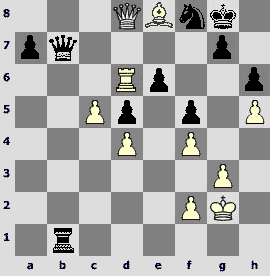
Black?
Black chose 1...¦e1? that let White finish the struggle strikingly: 2.¦d7!! ¤:d7 (2...Јb1 doesn't help Black either 3.¦:g7+! ўh8 4.¦h7+!! ўg8 5.¦h8+! ў:h8 6.Јf6+) 3.Ґ:d7+ (but not 3.Јe7? ўh8=) 3...ўh7 4.Ґe8! g5 5.hg+ ўg7 6.c6. Black resigned.
However, Aagaard noticed that Black could save himself.
1. . . . ¦b1-g1+!!
2.ўg2:g1 Јb7-b1+
3.ўg1-h2
3.ўg2 Јe4+.
3. . . . Јb1-f1
White's king can't escape perpetual check. For example: 4.Ґb5 Ј:f2+ 5.ўh1 Јf3+ 6.ўg1 Ј:g3+ 7.ўf1 Ј:f4+ (7...Јf3+ 8.ўe1 Јc3+) 8.ўe1 Јc1+ 9.ўf2 Јf4+ 10.ўe2 Јe4+ 11.ўd2 Ј:d4+ 12.Ґd3 Јf2+ 13.Ґe2 Јd4+ 14.ўe1 Јg1+.
Kaminsky – Stefansson
Cappelle-la-Grande1993

Black?
Black's position seems to be hard. The b7-pawn is too strong. In case of 1...Ґf6? White achieves the victory playing either 2.Јb6 or 2.¦ab3 ed 3.Ґa7. Not better is 1...Ґd4? 2.Ґ:d4 (simple 2.de is also enough) 2...Ј:d4 3.Јc7+ Јd7 4.¦c3 ed 5.Јf4ќ. In conclusion, useless is 1...f4? 2.de fg+ 3.fg Јg4 4.Јe1ќ.
The elegant combination concerned with the creation of the passed pawn rescues Black indeed.
1. . . . e4:d3!
Black threatens with 2...d2.
2.Ґc5-a7 ¦b8:b7!!
3.¦b1:b7 d3-d2!
4.¦b7:d7 ¦d8:d7
Draw.
I included the following example in my own collection of studies. However, soon afterwards I ascertained that it is quite controversial.
Gelfand – Shirov
Monte-Carlo (rapid) 2003
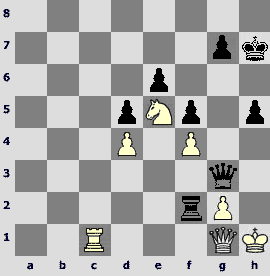
White?
Boris Gelfand chose 47.Јh2 Ј:h2+ 48.ў:h2 ¦:f4 49.¤f3 ўg6². Black has three pawns for the knight and he plans to move 50...ўf6 with the following 51...g5. The game was drawn.
In case of 47.¤f3 the natural continuation 47...Ј:f4 lets White achieve the advantage after 48.¦e1 Јg3 49.¤g5+! ўh6 50.¤h3. However, White has to reckon with 50...¦:f3! 48.gfЈ:f3+ 49.Јg2 Ј:f4 50.¦d1 (50.¦e1?? Јh4+) 50...g5. It is quite difficult to evaluate this position. The problem is that it is hard to make White's rook more active and therefore, it is unclear if the rook is stronger than the opponent's four pawns that are ready to move forward.
The following elegant combination seems to be the most dangerous for Black.
47.¦c1-c3! Јg3:f4
48.¦c3-h3 ¦f2-f1
Bad is 48...Ј:d4? 49.¤d3ќ.
49.¦h3:h5+ ўh7-g8
50.¦h5-h8+! ўg8:h8
51.¤e5-g6+ ўh8-g8
52.¤g6:f4
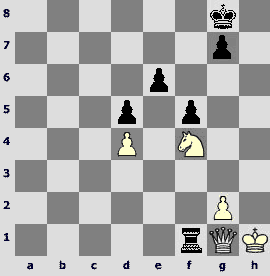
Black?
It seems to me that White will convert the extra piece after 52...¦:g1+ 53.ў:g1 ўf7 54.ўf2 g5 55.¤d3. However, Black unexpectedly takes the opponent's knight instead of the queen!
52. . . . ¦f1:f4!
Black's rook stands on e4 comfortably. It not only defends Black's pawns but also attacks the opponent's one and restricts the mobility of White's king.
At first sight, Black's fortress looks impregnable. As a matter of fact, White still has some chances for the victory. It is necessary to intrude into the opponent's camp by the queen. White needs the position when it is not advantageous for Black to take d4-pawn because of Ј:e6. The g6-square seems to be an ideal point for White's queen. Then White should play g2-g3, put his king on h3 and seize an opportunity of sacrificing a pawn g3-g4. If Black moves f5:g4+ White repliesўh4, advancing his king to the opponent's one. However, it is not clear if this plan is realizable and if it promises real chances for the victory.
Aagaard analyzed the following example.
Ivanov – Shmelev
USSR 1974
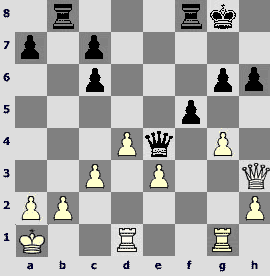
Black?
1. . . . ¦b8:b2!
Of course, the sacrifice of the rook suggests itself. The question is how White should defend this position.
2.ўa1:b2!
In case of 2.gf? both 2...Јc2 3.¦:g6+ ўf7 4.¦g7+ ўe8! 5.Јh5+ ўd8 6.Јh4+ ўc8 7.¦:c7+ ўb8! 8.¦:a7 ¦b5 and 2...¦:a2+ 3.ў:a2 Јc2+ 4.ўa3 Ј:c3+ 5.ўa4 Јc4+ 6.ўa3 Јa6+ 7.ўb2 ¦b8+ 8.ўc3 Јa3+ 9.ўd2 ¦b2+ 10.ўe1 Јc3+ 11.ўf1 Јc4+ are winning for Black. By the way, I examined the similar way of chasing the opponent's king when I analyzed the game Popov – Makarychev (in the book "High skill school 2 – Combinational game" – studies 4-38). Well, nothing seems to be new in this world.
Unsatisfactory is 2.¦b1? ¦:b1+ (or 2...fg 3.Јg3 ¦:b1+) 3.¦:b1 Јc2 4.e4 fg 5.Јg3 (5.Јe3 ¦f2°) 5...h5°.
2. . . . ¦f8-b8+
3.ўb2-c1
3.ўa1? Јc2°.
3. . . . f5-f4!
Straightforward 3...¦b1+ 4.ўd2 ¦b2+ 5.ўe1 Јc2 doesn't pose the problems to the opponent. White can either go for the unclear ending playing 6.¦g2 Ј:g2 7.Ј:g2 ¦:g2 8.gf or to force perpetual by 6.Јf3 Ј:c3+ 7.ўf1 Јc4+ 8.ўe1.
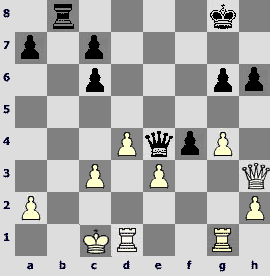
White?
There was only one move more in this game: 4.ef?? ¦b1+. White resigned.
4.ўd2? also loses quickly after4…¦b2+ 5.ўe1 f3!. Hopeless is 4.¦g2? ¦b1+ 5.ўd2 ¦b2+ 6.ўe1 ¦:g2. The only chance consists in realizing the counter-attack!
4.g4-g5!! f4:e3
The draw is obvious after 4...¦b1+ 5.ўd2 ¦b2+ (5...fe+? 6.ўe2! ¦b2+ 7.ўe1) 6.ўe1 f3 7.Јc8+ ўh7 8.Ј:c7+ ўg8 with the perpetual. On 4...hg it is possible to play either 5.¦d3!? or 5.ўd2!? f3 6.¦b1!=. At last, in the variation 4...f3 5.¦d3!! Ј:d3 6.Јe6+ ўf8 7.Јf6+ ўe8 8.Ј:c6+! ўd8 9.Јf6+ (9.Јd5+) 9...ўc8 10.Јe6+ (but not 10.Јf8+? ўb7 11.Ј:f3+ ўa6 12.Јc6+ ¦b6 13.Јa4+ ўb7°) 10...ўb7 11.Јb3+! Black's king can't hide from the opponent's queen.
5.¦d1-d3!! Јe4:d3
6.Јh3-e6+
White achieves the draw by the same kind of perpetual as it was after 4...f3.
Kasparov – Smirin
USSR Championship, Moscow 1988
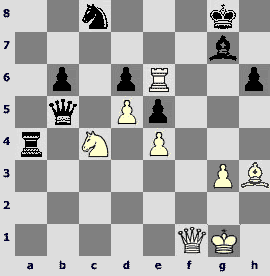
Black?
Having played 38.Ґg2-h3!? White posed an interesting problem to his opponent and the fact is that Ilya Smirin couldn't resolve it.
Having chosen 38...¦:c4? (even worse is 38...Ј:c4?? 39.¦e8+), he let the 13th world champion finish this game strikingly: 39.¦:h6!! Ґ:h6 (if 39...Јc5+ 40.ўh1 ¦c1 then 41.Ґe6#) 40.Ґe6+ ўh8 41.Јf6+. Black resigned in view of unavoidable checkmate after 41...ўh7 (41...Ґg7 42.Јh4+) 42.Јf7+ Ґg7 43.Ґf5+ ўh8 44.Јh5+ ўg8 45.Ґe6+.
Garry Kasparov and Alexander Nikitin consider that White wins this game in any case. Moreover, they appreciate White's combination as an excellent conclusion of the previous strategy. But is that so? Let's try to find a defense against the dreadful blow on h6.
After 38...¦a7?! the combination gives White nothing. However, in case of 39.¤e3 Ј:f1+ 40.ў:f1 White achieves a serious advantage in the endgame. Black's pieces are too passive.
However, Black has one more opportunity.
38. . . . h6-h5!!
Indicated by Ilya Odessky. Black threatens with taking the knight and after 39.¦h6? Ґ:h6 h5-pawn closes h-file and now it is Black who wins: 40.Ґe6+ ўh8 41.Јf6+ Ґg7 42.Јd8+ ўh7. To my mind, White doesn't have anything better than liquidating into the ending.
39.¤c4-e3 Јb5:f1+
40.ўg1:f1 ¦a4:e4
The cautious 40...ўf8?! is worse because of 41.Ґf5±.
41.¤e3-f5 Ґg7-f8
Erroneous is 41...ўf8? 42.¤:g7 ў:g7 43.¦e8 and Black loses the knight.
42.¦e6-e8

Black?
42. . . . ¤c8-e7!!
The main point of Black's plan. Both 42...¤a7? 43.¤:d6 and 42...¦c4? 43.¤h6+ ўg7 44.Ґ:c8 loses.
43.¤f5:e7+
43.¦:e7 Ґ:e7 44.¤:e7+ ўf8 doesn't change anything. It is also difficult to struggle for the victory after 43.¤:d6 ¦d4!? 44.Ґe6+ ўg7.
43. . . . ўg8-f7
44.¦e8:f8+ ўf7:f8
45.¤e7-f5 b6-b5!?
46.¤f5:d6 ¦e4-d4
The game must be drawn.
Inarkiev – Tregubov
Moscow 2002

White?
Black's rook has just moved from h8 on d8. Apparently, the idea of Black consists in forcing out the opponent's rook from the 7th rank by 35...Ґf8. Instead of this continuation, both 34...Ј:f3 and 34...ўa8 provided Black with the decisive advantage.
But the fact is that now life is not easy for White either. Black has an extra pawn and it is quite difficult to find some kind of a counter-play. Let's analyze several attempts.
35.f4? ¦h2! 36.¤e5 (worse is 36.¤a6+ ba 37.¤b4 Јf5+ 38.ўa1 ¦c8°) 36...¤b5! ( 36...Ґ:e5 37.¦1:e5 is less sensible) 37.¦:b7+ ўa8°;
35.Јd2? Ґf8! 36.¦d7 (Black definitely has the upper hand after 36.¤d7+ ¦:d7 37.¦:d7 ўc8 38.¦:d6 Ґ:d6°) 36...¤c4! 37.Јb4 ¤d2+! 38.Ј:d2 ¦:d7 39.¤:d7+ Ј:d7°;
35.¤e5? Ґ:e5 36.¦1:e5 Ј:f3°. These moves were made in the game and Black simply converted his material advantage.
However, White had an unusual way of saving this position. Moreover, he even had a chance of catching initiative in case of the opponent's error.
35.¦e1-e4!!
It is very important to take the 4th rank under control. After it White's combinational resources on the queenside become richer. Now Black has to resolve a serious problem. It is necessary to get out of the difficulties with the least losses.
35. . . . ¤d6:e4?!
Bad is 35...¦h2? because White ignores a menace to b2-square: 36.¤b4! Јf5 (36...¦:b2+ 37.Ј:b2ќ) 37.¤ca6+ ўa8 (37...ba 38.¤:a6+ ўa8 39.Ј:c6+) 38.¤c7+ ўb8 39.¤:c6+ ўc8 40.¤a6ќ.
The strongest continuation is 35...¦:e4! 36.fe Јd4. White can immediately force a draw playing 37.¦:b7+ ¤:b7 38.¤a6+ ўa8 39.¤c7+ ўb8 40.¤a6+ but he can also try 37.e5!?. However, after the only but sufficient reply 37...Ґf8! doubtful is 38.ed Ґ:e7 39.de ¦e8³ and therefore White has to force the perpetual: 38.¦:b7+! ¤:b7 39.¤a6+ ўa8 40.¤c7+.
Taking on e4 looks like to be more fundamental but the fact is that this continuation creates serious problems for Black.
36.f3:e4 Јd5-d6!
Bad is 36...Јd4? 37.¦:b7+ ўa8 38.¦b4 Јd6 39.e5 (suddenly h4-rook turned out to be under attack).
37.¦e7:b7+ ўb8-a8
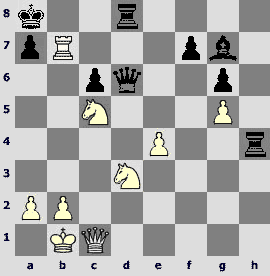
White?
38.Јc1-e1!
Queen strives for a5-square. At the same time White attacks the opponent's rook. Worse is 38.¦:f7? Ґd4 39.¤b7 because of 39...Јg3!°.
38. . . . ¦d8-h8
The only move.
39.Јe1-a5!
Now the perpetual after 39.¦:a7+ ў:a7 40.Јa5+ ўb8 41.Јb6+ ўc8 42.Јa6+ ўc7 doesn't suit White.
39. . . . ¦h4-h1+
40.ўb1-c2 ¦h1-h2+
41.ўc2-b3 Јd6:d3+
It looks like Black doesn't have any better move.
42.¤c5:d3 ўa8:b7
43.ўb3-a4!?
White is going to check on b4. There is no doubt that White has the upper hand.
Motylev – Wojtaszek
Europe Championship, Warsaw 2005
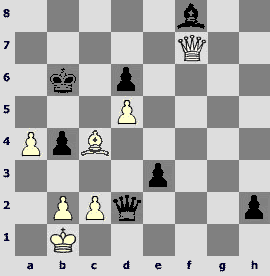
White?
Black's pawns bound forward and it seems to be impossible to stop them. The only hope consists in the counter-attack. The presence of the bishops of opposite color increases the chances of realizing a successful counter-attack. Black's dark-squared bishop can't save from the attack on light squares. The question is if Black's queens manage to do it.
It is quite impossible to resolve such problems with the stupid time control that is practiced by FIDE. Even so inventive chessplayer as Alexander Motylev didn't cope with the task and lost without struggle: 41.Ґf1? b3 (also strong is 41...e2!?) 42.cb h1Ј 43.Ј:f8 Јh:d5 44.Ґc4 Јb7 45.ўa2 ўa7 46.Јf4 and White resigned.
Sergey Erenburg demonstrated a saving way to the draw when he commented the game for Chessbase.
41.a4-a5+! ўb6-c5
42.Ґc4-b3!! h2-h1Ј+
43.ўb1-a2
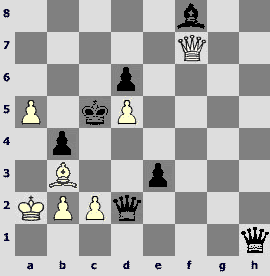
White threatens with the checkmate in two moves: 44.Јa7+ ўb5 45.Јb6#.
а) 43...ўd4 44.Јf4+ Јe4 45.Јf6+ ўc5 (45...Јe5 46.Јh4+) 46.Јd8! (threatening with 47.Јb6#) 46...ўd4 47.Јf6+;
б) 43...Јh:d5 44.Јa7+ ўc6 (44...ўb5?? 45.Јb6#) 45.Јa8+ ўb5 46.Ґ:d5 b3+ 47.Ґ:b3 Ј:a5+ 48.Ј:a5+ ў:a5 49.Ґc4=.
By the way, a right order of moves is very important in this position. The attempt of beginning with 41.ўa2?! (it is also possible to try 41...h1Ј with the same idea 42.a5+ ўc5 43.Ґb3) runs into 41...b3+!! 42.cb h1Ј 43.Јd7 and now Black plays either 43...Јh3!? 44.Јc6+ (44.Ј:h3? Ґg7°) 44...ўa7 45.Јc7+ ўa8 or 43...Јh:d5!? 44.Ґ:d5 Ј:d5 45.Јd8+ ўc5 46.Ј:f8 ўd4. According to Aagaard's analysis, White keeps the winning chances in any case.
Topalov – Polgar
Wejk-an-Zee 2005
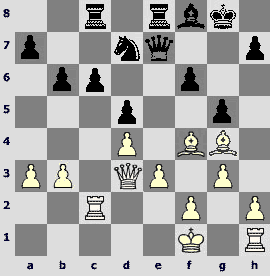
White?
Recently Veselin Topalov carelessly played e2-e3? and his bishop turned out to be locked in. Judit Polgar has just attacked the opponent's bishop by her pawn. Now White wants to give up the bishop at a high price.
23.Јd3-f5!
Weaker is 23.Ґ:g5 fg 24.h4 gh 25.¦:h4 ўh8 (it is not bad either to play 25...¦c7 26.Ґe6+ ўh8 27.Ґ:d5 ¤c5! 28.dc cdµ) 26.¦:h7+ (26.Ґf5 h6) 26...Ј:h7 27.Ј:h7+ ў:h7 28.Ґ:d7 ¦ed8 29.Ґ:c8 ¦:c8µ.
23. . . . g5:f4
Black stood slightly better after 23...¦ed8!? 24.¦:c6 ¦:c6 25.Ј:d5+ ўh8 26.Ј:c6 gf 27.gf ¤b8 28.Јc4 (or 28.Јe6 Ј:e6 29.Ґ:e6 Ґ:a3 30.ўe2) but Polgar wants more.
After 24.gf? ўh8 25.¦g1 (worse is 25.Ј:d7 Јe4 26.¦g1 Ј:c2 27.Ґf5 Јd1+ 28.ўg2 Јh5°) 25...¦c7 she kept an extra piece just for a pawn and gradually converted it. However, Dmitry Tyomkin showed that it was possible to improve White's defense.
24.Јf5:d7! Јe7-e4
Obviously, Topalov refused taking the knight because of this double blow.
25.¦h1-g1!! Јe4:c2
25...fe!?deservesattentionindeed.If 26.Ґf5 then instead of 26...¦c7 27.Ј:c7 Ј:f5 28.¦e2 (Tyomkin) with the equal chances White should choose 26...e2+! 27.ўe1 ¦c7!. That's why White plays 26.¦e2! ¦cd8 27.¦:e3 Ј:d4 (27...¦:d7 28.¦:e4 ¦:e4 29.Ґ:d7 and White can defend this ending) 28.Ґe6+ ўh8 29.Јf7 Ґc5 (Black threatens with 30...¦e7).

White?
30.Јc7!! Ґd6 (Black has to reckon with 31.Ґf5) 31.Ј:c6 Ґ:a3 32.ўg2³ and White can count on a draw (Aagaard's analysis).
26.Ґg4-f5
Soon it will become clear why White refrains from taking on f4 (the variation 26.gf? ўh8 27.Ґf5 Јd1+ 28.ўg2 Јh5° is already known).
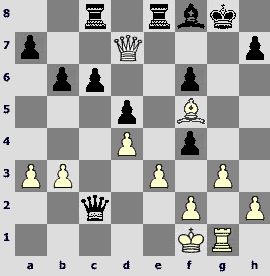
26. . . . Јc2-d1+
27.ўf1-g2 Јd1-h5
28.Ґf5-e6+! ўg8-h8
29.Ґe6-f7
This double blow seems to be the main point of White's defense.
29. . . . ¦e8-d8
30.Јd7:c8!
But not 30.Ј:d8? Јf5!!°.
30. . . . ¦d8:c8
31.Ґf7:h5 f4:e3
32.f2:e3
The game is even.
Black has an interesting attempt in this position: 26...¦c7!? 27.gf+ ўh8. In case of 28.Ј:c7? Ј:f5 29.Јf7 Јb1+ 30.ўe2 (30.ўg2? Јg6+) 30...Ј:g1 31.Ј:e8 Јg4+ 32.ўe1 ўg7 Black keeps an extra piece and he has a right to count on a total success. It is necessary to move 28.Ј:e8 Јd1+ 29.ўg2 ¦g7+ 30.ўh3 Ј:g1 31.Ј:f8+ ¦g8 32.Ј:f6+ Јg7!? and White plays either 33.Ј:g7+ ¦:g7 34.b4 (Tyomkin) or 33.Јe5!? with the mutual chances.
Belikov – Saulin
Russian Championship, Elista 1995
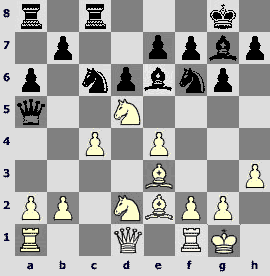
Black?
Difficult problems always have simple wrong solutions (from the famous book "Murphy's laws"). For a long time I have used this example as a study for training an attentive attitude to the opponent's counter-chances.
The logic seems to be clear. White's menaces 14.¤b6 and 14.Ґb6 can be repelled by 13...¤d7. However, White has a strong tactical reply and Black has to play 13...Ґ:d5 against his own will: 14.cd ¤e5 (a typical use of the "method of exception"). To tell the truth, Black's position after 15.f4 ¤ed7 16.Ґd3 is not attractive at all. However, it looks like there is no choice.
Well, why 13...¤f6-d7!? is so bad?
13. . . . ¤f6-d7!?
14.Ґe3-b6! ¤d7:b6
15.¤d2-b3
Black loses material.
15...¤:d5? 16.¤:a5 ¤c3. Other bounces of knight don't help Black either.
16...¤b6 17.¤:c6 ¦:c6 18.b3! Ґ:a1 19.Ј:a1 ¤d7 20.f4 and White's material advantage should tell.
16...¤f4!? 17.¦e1!? (17Ґf3 also deserves attention. On 17...Ґ:c4 White continues 18.e5!) 17...Ґ:b2 (17...¤:e2+ 18.¦:e2 Ґ:c4 19.¦c2) 18.¦b1 Ґc3 19.¦:b7 Ґ:e1 20.Ј:e1 and life is not easy for Black again.
17.¤:c6! ¤:d1 18.¤:e7+ ўf8 19.¤:c8 ¤:b2 20.¤b6 ¦a7. A strange move. The following variation seems to be a more natural attempt to help Black's knight that is stuck in the opponent's camp - 20...¦e8 21.¦ab1 f5. But even then White keeps a decisive advantage playing 22.e5! Ґ:e5 23.¦fc1 Ґd4 24.¦c2 Ґ:b6 25.¦b:b2 with the following 26.¦:b7.
21.¦ab1 a5 22.¦fc1 Ґd4 23.¦c2. Black resigned.
It is a pity if you have chosen 13...¤d7 only because you have overlooked 14.Ґb6!. To the contrary, it is very well if you have foreseen the opponent's tactical blow and have prepared this positional exchange sacrifice (suggested by Simen Agdestein).
15. . . . Јa5-a4!
16.¤d5:b6 Јa4-b4
17.¤b6:a8 ¦c8:a8
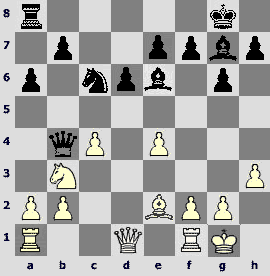
Black threatens with taking the pawn 18...Ґ:c4 or 18...Ґ:b2. Moreover, White has to reckon with 18...a5 and 18...¦c8. I didn't manage to prove White's advantage. To my mind, Black has an enough counter-play. This way is more promising than the cheerless defense after 13...Ґ:d5.
I hope that the training of defending difficult positions will help you when resolving the studies of the article's following parts and playing tournament games. I also recommend you to find my publication "Saving combinations" on www.chesspro.ru (or the same article in English on www.chesscafe.com).
